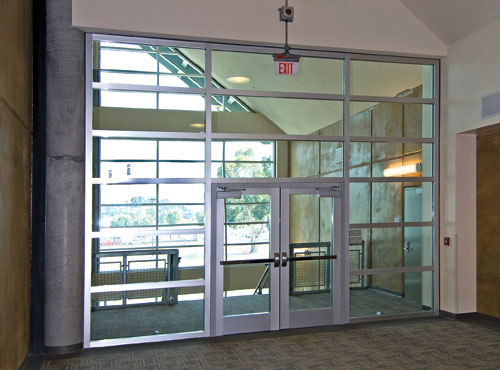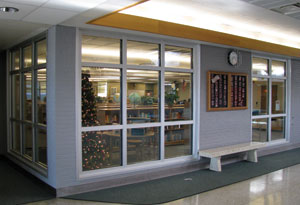First in Their Class: Innovative Design Solutions for Schools of the Future
Hallways, Fire Safety and Transparency
New products that open up classroom flexibility indoors and outdoors, in fact, can provide not only fire safety, but transparency along corridors or as part of new learning clusters. According to Jeff Griffiths, director of business development with SAFTI FIRST, as an increased measure of safety, design professionals are encouraged to "look at not just the fire rating of a system, but the ability of fire-resistant glass to stop the transmission of radiant heat from one area to another."
 |
Fire-resistive glass assemblies can create a sense of openness, add natural lighting, and increase the visibility to safe pathways. Photo courtesy of SAFTI FIRST |
Fire-resistant safety glass is available for architects who want to design a school that meets fire codes without sacrificing visual continuity and transparency. Some newer fire-resistive glass is comprised of two pieces of tempered glass with an intumescent gel product in the middle. In a fire, the glass facing the fire will break as the temperature reaches about 400 to 500 °F. When the glass breaks, the gel solidifies and expands to create the equivalent of a fire-rated, masonry barrier wall.
Case Study: North Layton Junior High School, Layton, Utah |
|
AJC Architects of Salt Lake City, Utah, needed a solution for the renovation of the media center and new counseling center for North Layton Junior High School. They discovered that they could take advantage of a clear fire-rated glazing to keep the look of the media center and provide an open, welcoming entrance to the new counseling center.
"Prior to the renovation, masonry and non-rated hollow metal storefront and glazing were used in the building. Due to the increased square footage of the building, new fire-rated areas needed to be created," says Jodi Geroux, AIA, LEED AP of AJC Architects. "The existing hollow metal storefront glazing was located in walls that needed to be upgraded to 1- and 2-hour fire walls." To achieve this, the design team chose a glass wall system that would meet the code requirements and maintain the building's original design, which incorporated a lot of glazing. They wanted a product with both an impact safety rating and a 2-hour fire rating that would meet ASTM E-119, the stringent wall criteria that limits the average glass surface temperature rise to 250 °F on the non-fire side. ASTM E-119 performance standards apply where fire ratings of 60 minutes or more are required in order to protect against dangerous radiant heat and provide a safe path of egress in the event of a fire. Tested and approved in large sizes, fire-resistant glass can be combined with 60- to 120-minute aluminum-clad framing to provide wall-to-wall and floor-to-ceiling expanses of glass that provide beauty, elegance and maximum fire safety within a school's tight construction budget. |










